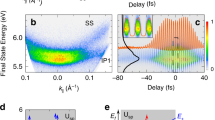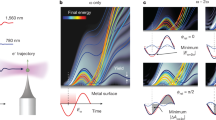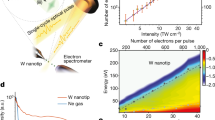Abstract
Strong-field physics, an extreme limit of light–matter interaction1,2,3, is expanding into the realm of surfaces4,5 and nanostructures6,7,8,9,10,11 from its origin in atomic and molecular science12,13,14,15. The attraction of nanostructures lies in two intimately connected features: local intensity enhancement and sub-wavelength confinement of optical fields. Local intensity enhancement facilitates access to the strong-field regime and has already sparked various applications, whereas spatial localization has the potential to generate strong-field dynamics exclusive to nanostructures. However, the observation of features unattainable in gaseous media is challenged by many-body effects and material damage, which arise under intense illumination of dense systems16,17,18,19. Here, we non-destructively access this regime in the solid state by employing single plasmonic nanotips and few-cycle mid-infrared pulses, making use of the wavelength-dependence of the interaction, that is, the ponderomotive energy. We investigate strong-field photoelectron emission and acceleration from single nanostructures over a broad spectral range, and find kinetic energies of hundreds of electronvolts. We observe the transition to a new regime in strong-field dynamics, in which the electrons escape the nanolocalized field within a fraction of an optical half-cycle. The transition into this regime, characterized by a spatial adiabaticity parameter, would require relativistic electrons in the absence of nanostructures. These results establish new degrees of freedom for the manipulation and control of electron dynamics on femtosecond and attosecond timescales, combining optical near-fields and nanoscopic sources.
This is a preview of subscription content, access via your institution
Access options
Subscribe to this journal
Receive 51 print issues and online access
$199.00 per year
only $3.90 per issue
Buy this article
- Purchase on Springer Link
- Instant access to full article PDF
Prices may be subject to local taxes which are calculated during checkout




Similar content being viewed by others
References
Keldysh, L. V. Ionization in the field of a strong electromagnetic wave. Sov. Phys. JETP 20, 1307–1314 (1965)
Corkum, P. B. Plasma perspective on strong-field ionization. Phys. Rev. Lett. 71, 1994–1997 (1993)
Paulus, G. G., Becker, W. & Walther, H. Classical rescattering effects in two-color above-threshold ionization. Phys. Rev. A 52, 4043–4053 (1995)
Irvine, S. E., Dechant, A. & Elezzabi, A. Y. Generation of 0.4-keV femtosecond electron pulses using impulsively excited surface plasmons. Phys. Rev. Lett. 93, 184801 (2004)
Rácz, P. et al. Strong-field plasmonic electron acceleration with few-cycle, phase-stabilized laser pulses. Appl. Phys. Lett. 98, 111116 (2011)
Bormann, R., Gulde, M., Weismann, A., Yalunin, S. V. & Ropers, C. Tip-enhanced strong-field photoemission. Phys. Rev. Lett. 105, 147601 (2010)
Krüger, M., Schenk, M. & Hommelhoff, P. Attosecond control of electrons emitted from a nanoscale metal tip. Nature 475, 78–81 (2011)
Schenk, M., Krüger, M. & Hommelhoff, P. Strong-field above-threshold photoemission from sharp metal tips. Phys. Rev. Lett. 105, 257601 (2010)
Zherebtsov, S. et al. Controlled near-field enhanced electron acceleration from dielectric nanospheres with intense few-cycle laser fields. Nature Phys. 7, 656–662 (2011)
Kim, S. et al. High-harmonic generation by resonant plasmon field enhancement. Nature 453, 757–760 (2008)
Sivis, M., Duwe, M., Abel, B. & Ropers, C. Nanostructure-enhanced atomic line emission. http://dx.doi.org/10.1038/nature10978 Nature (in the press)
Hentschel, M. et al. Attosecond metrology. Nature 414, 509–513 (2001)
Krausz, F. & Ivanov, M. Attosecond physics. Rev. Mod. Phys. 81, 163–234 (2009)
Sansone, G. et al. Isolated single-cycle attosecond pulses. Science 314, 443–446 (2006)
Colosimo, P. et al. Scaling strong-field interactions towards the classical limit. Nature Phys. 4, 386–389 (2008)
Gilton, T. L., Cowin, J. P., Kubiak, G. D. & Hamza, A. V. Intense surface photoemission: space charge effects and self-acceleration. J. Appl. Phys. 68, 4802–4810 (1990)
Aeschlimann, M. et al. Observation of surface enhanced multiphoton photoemission from metal surfaces in the short pulse limit. J. Chem. Phys. 102, 8606–8613 (1995)
Petite, G., Agostini, P., Trainham, R., Mevel, E. & Martin, P. Origin of the high-energy electron emission from metals under laser irradiation. Phys. Rev. B 45, 12210–12217 (1992)
Passlack, S. et al. Space charge effects in photoemission with a low repetition, high intensity femtosecond laser source. J. Appl. Phys. 100, 024912 (2006)
Einstein, A. Über einen die Erzeugung und Verwandlung des Lichtes betreffenden heuristischen Gesichtspunkt. Ann. Phys. 322, 132–148 (1905)
Lenard, P. Ueber die lichtelektrische Wirkung. Ann. Phys. [transl. C.R. and G.H.]. 313, 149–198 (1902)
Meckel, M. et al. Laser-induced electron tunneling and diffraction. Science 320, 1478–1482 (2008)
Ropers, C., Solli, D. R., Schulz, C. P., Lienau, C. & Elsaesser, T. Localized multiphoton emission of femtosecond electron pulses from metal nanotips. Phys. Rev. Lett. 98, 043907 (2007)
Hommelhoff, P., Sortais, Y., Aghajani-Talesh, A. & Kasevich, M. A. Field emission tip as a nanometer source of free electron femtosecond pulses. Phys. Rev. Lett. 96, 077401 (2006)
Hommelhoff, P., Kealhofer, C. & Kasevich, M. A. Ultrafast electron pulses from a tungsten tip triggered by low-power femtosecond laser pulses. Phys. Rev. Lett. 97, 247402 (2006)
Süßmann, F. & Kling, M. F. Attosecond nanoplasmonic streaking of localized fields near metal nanospheres. Phys. Rev. B 84, 121406 (2011)
Stockman, M. I., Kling, M. F., Kleineberg, U. & Krausz, F. Attosecond nanoplasmonic-field microscope. Nature Photon. 1, 539–544 (2007)
Bouhelier, A., Beversluis, M., Hartschuh, A. & Novotny, L. Near-field second-harmonic generation induced by local field enhancement. Phys. Rev. Lett. 90, 013903 (2003)
Huber, A. J., Keilmann, F., Wittborn, J., Aizpurua, J. & Hillenbrand, R. Terahertz near-field nanoscopy of mobile carriers in single semiconductor nanodevices. Nano Lett. 8, 3766–3770 (2008)
Yalunin, S. V., Gulde, M. & Ropers, C. Strong-field photoemission from surfaces: theoretical approaches. Phys. Rev. B 84, 195426 (2011)
Acknowledgements
We thank R. Bormann, F. Schenk, M. Sivis and S. V. Yalunin for discussions. Financial support by the Deutsche Forschungsgemeinschaft (DFG-ZUK 45/1 and SPP 1391) is gratefully acknowledged.
Author information
Authors and Affiliations
Contributions
All authors were closely involved in this study and contributed to the ideas, realization of the experiments, data analysis and interpretation, and writing of the paper.
Corresponding author
Ethics declarations
Competing interests
The authors declare no competing financial interests.
Supplementary information
Supplementary Information
This file contains Supplementary Text and Data and Supplementary Figures 1-5. (PDF 493 kb)
Rights and permissions
About this article
Cite this article
Herink, G., Solli, D., Gulde, M. et al. Field-driven photoemission from nanostructures quenches the quiver motion. Nature 483, 190–193 (2012). https://doi.org/10.1038/nature10878
Received:
Accepted:
Published:
Issue Date:
DOI: https://doi.org/10.1038/nature10878
This article is cited by
-
Dual-chirped optical parametric amplification of high-energy single-cycle laser pulses
Nature Photonics (2024)
-
Attosecond electron microscopy by free-electron homodyne detection
Nature Photonics (2024)
-
Controlling Plasmonic Field Enhancement via the Interference of Orthogonal Plasmonic Modes
Plasmonics (2024)
-
Few-femtosecond phase-sensitive detection of infrared electric fields with a third-order nonlinearity
Communications Physics (2023)
-
Few-electron correlations after ultrafast photoemission from nanometric needle tips
Nature Physics (2023)
Comments
By submitting a comment you agree to abide by our Terms and Community Guidelines. If you find something abusive or that does not comply with our terms or guidelines please flag it as inappropriate.



